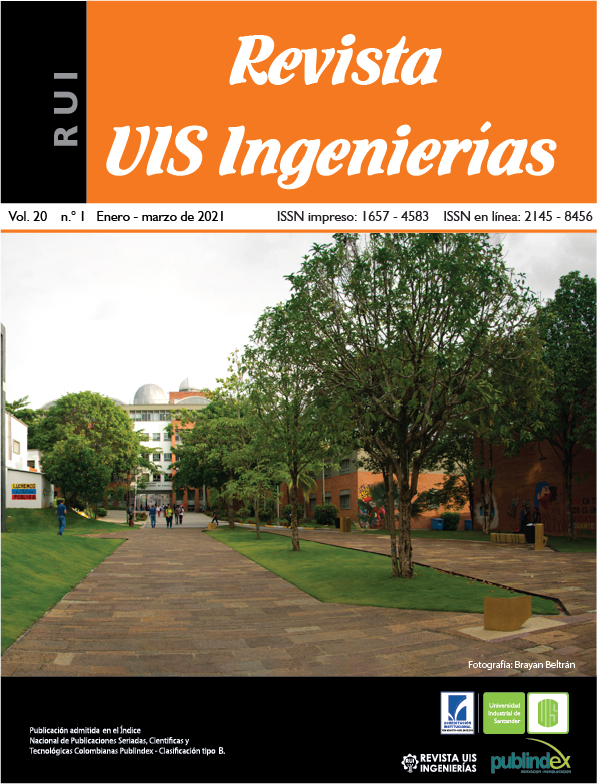Publicado 2020-10-27
Palabras clave
- transferencia de calor,
- convección natural,
- capa límite,
- región laminar,
- región turbulenta
- transición,
- número de Rayleigh,
- número de Nusselt,
- esfera,
- modelo laminar,
- modelo de turbulencia,
- modelo k-ε,
- Ansys Fluent ...Más
Cómo citar
Derechos de autor 2020 Revista UIS Ingenierías

Esta obra está bajo una licencia internacional Creative Commons Atribución-SinDerivadas 4.0.
Resumen
La mayor parte de las investigaciones que se han realizado sobre la convección natural han abordado su estudio en la región laminar y no se ha dirigido mucha atención a la convección natural turbulenta que suele presentarse cuando el número de Rayleigh supera un cierto valor crítico. Estudios recientes han mostrado que las correlaciones existentes para esta región suelen ser poco precisas. Por otra parte, el tratamiento numérico de este problema presenta dificultades relacionadas con el modelo de turbulencia usado, ya que se está en presencia de una capa límite laminar-turbulenta en un entorno laminar, por lo cual, el modelo laminar subestimará la transferencia de calor, mientras los modelos turbulentos la sobreestimarán. Modelos transicionales y otras opciones están disponibles, pero están diseñados para entornos turbulentos. El presente trabajo plantea la solución numérica mediante el programa computacional Ansys Fluent de la convección laminar turbulenta en torno a esferas sin modelo de turbulencia (modelo laminar) y usando un modelo de turbulencia k-ε para bajos números de Reynolds. El trabajo permitió caracterizar los números de Rayleigh a partir de los cuales empieza a ocurrir el cambio de capa límite laminar a turbulenta, así como la posición del desprendimiento de la capa límite. Los valores obtenidos para la transferencia de calor con el modelo laminar muestran muy buena concordancia con experimentos y correlaciones para bajos números de Rayleigh, pero pierde precisión a partir de cierto valor de Rayleigh, aspecto que pudo corregirse satisfactoriamente incorporando el modelo de turbulencia utilizado.
Descargas
Referencias
[2] K. Kitamura, A. Mitsuishi, T. Suzuki, T. Misumi, “Fluid flow and heat transfer of high-Rayleigh-number natural convection around heated spheres,” International Journal of Heat and Mass Transfer, vol. 86, pp. 149-157, 2015, doi: 10.1016/j.ijheatmasstransfer.2015.02.081
[3] W. Amato, C. Tien, “Free convection heat transfer from isothermal spheres in water,” International Journal of Heat and Mass Transfer, vol. 15, no. 2, pp. 327-339, 1972, doi: 10.1016/0017-9310(72)90078-6
[4] B. Launder, D. Spalding, “The numerical computation of turbulent flows,” Computer Methods in Applied Mechanics and Engineering, vol. 3, no. 2, pp. 269-289, 1974, doi: 10.1016/0045-7825(74)90029-2
[5] D. Wilcox, “Formulation of the k-ω turbulence model revisited,” AIAA Journal, vol. 46, pp. 2823-2838, 2008, doi: 10.2514/1.36541
[6] F. Menter, “Two-equation Eddy-viscosity turbulence models for engineering applications,” AIAA Journal, vol. 32, no. 2, pp. 1598-1605, 1994, doi: 10.2514/3.12149
[7] R. Lantry, “A correlation-based transition model using local variables for unstructured parallelized CFD code,” Tesis doctoral, Universidad de Stuttgart, Alemania, 2006.
[8] S. Dmitriev, A. Kozelkov, A. Kurkin, N. Tarasova, V. Efremov, V. Kurulin, R. Shamin, M. Legchanov, “Simulation of turbulent convection at high Rayleigh numbers,” Modelling and Simulation in Engineering, vol. 2018, pp. 1-12, 2018, doi: 10.1155/2018/5781602
[9] A. Filippov, “Numerical simulation of experiments on turbulent natural convection of heat generating liquid in cylindrical pool,” Journal of Engineering Thermophysics, vol. 20 no. 1, pp. 64-76, 2011, doi: 10.1134/S1810232811010061
[10] S. Yang, V. Raghavan, G. Gogos, “Numerical study of transient laminar natural convection over an isothermal sphere,” International Journal of Heat and Fluid Flow, vol. 28, pp. 821-837, 2007, doi: 10.1016/j.ijheatfluidflow.2006.08.004
[11] A. Abir, M. Emin, “A comparative study of four low-Reynolds-number k-ε turbulence models for periodic fully developed duct flow and heat transfer,” Numerical Heat Transfer, Part B: Fundamentals, vol. 69, no. 3, pp. 234-248, 2016, doi: 10407790.2015.1097141
[12] Q. Wang, W. Li, Z. Chen, D. Kukulka, “Numerical analysis on natural convection in varios enclosures,” Numerical Heat Transfer, Part A: Applications, vol. 77, no. 4, pp.391-408, 2020, doi: 10.1016/j.ijthermalsci.2007.10.018
[13] F. Mebarek, R. Bessaih, “Numerical simulation of natural convection heat transfer of copper-watr nanofluid in a vertical cylindrical annulus with heat sources,” Thermophysics and Aeromechanics, vol. 26, pp. 325-334, 2019, doi: 10.1134/S0869864319030028
[14] Q. Yu, C. Zhang, Y. Wu, B. Sunden, “Experimental and numerical study of natural convection in botton-heated cylindrical cavity filled with molten salt nanofluids,” Journal of Thermal Analysis and Calorimetry, vo. 141, pp. 1207-1219, 2020, doi: 10.1007/s10973-019-09112-9
[15] K. Abe, T. Kondoh, Y. Nagano, “A new turbulence model for predicting fluid flow and heat transfer in separating and reattaching flows – I. flow field calculations,” International Journal of Heat and Mass Transfer, vol. 37, pp. 139-151, 1994, doi: 10.1016/0017-9310(94)00252-Q
[16] R. Arévalo, A. Abánades, L. Rebollo, “Numerical research of film boiling heat transfer around a vertical short cylinder flat or hemispherical ends,” Journal of Heat Transfer, vol. 138, pp. 1-7, 2016, doi: 10.1115/1.4033094
[17] R. Arévalo, D. Antúnez, L. Rebollo, A. Abánades, “Estimation of radiation coupling factors in film boiling around spheres by mean of computational fluid dynamics (CFD) tools,” International Journal of Heat and Mass Transfer, vol. 78, pp. 84-89, 2014, doi: 10.1016/j.ijheatmasstransfer.2014.06.063
[18] A. Abánades, R. Arévalo, L. Rebollo, “Numerical prediction of the mean temperature of the vapor film in film boiling heat transfer,” Computational Thermal Sciences, vol. 8, no. 1, pp. 1-10, 2016, doi: 10.1615/ComputThermalScien.2015014392
